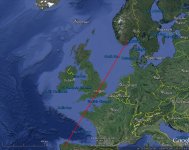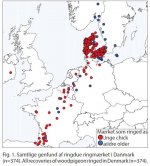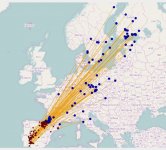If you are happy that the only plausible explanation for the large numbers of Wood Pigeons migrating over Britain in the autumn is an influx of continental birds then fine, but I will have to disagree.
We have a breeding population of 5.3 million pairs so the autumn population is probably over 15 million and could easily be over 20 million; that's more than enough to account for the numbers seen on migration.
I agree that Wood Pigeons often move at a great height, but it's not safe to assume that these are continental birds. The possibility that British birds will also move at great height cannot be dismissed; what evidence makes you sure that these aren't birds from further north in Britain?
It's clear that the authors of the latest Bird Atlas 2007-11 don't share your conviction as they note that “the degree of integration between populations within Britain & Ireland or between Britain & Ireland and continental Europe is uncertain”.
I would be much more comfortable with the idea of significant numbers of continental Wood Pigeons reaching Britain if this movement was being detected on the east coast, but it isn't. We know that Wood Pigeons can be forced down by bad weather and the Swedish study I quoted showed that they could be drifted by wind conditions.
That being the case it's reasonable to expect falls to occur on the east coast, but the evidence is very limited:-
Fair Isle – less than 50 per year
Spurn Report 2012 “autumn passage was again light” and 2013 “autumn passage was almost non-existent”.
Another observer said that checking the 'Scottish Bird Reports' from 1968 to 2000 produced “a mere handful of records of small numbers of the species at likely migratory spots, and in some years none at all”.
You suggest that the lack of east coast records is because they overfly it at great height, but a scenario where they always avoid being grounded by bad weather is highly unlikely. Falls happen regularly with thrushes for example and it would be inevitable that occasionally Wood Pigeons would set off in good weather conditions and then encounter a rain bearing front as they approached Britain and be forced down.
With regard to flight times and the suggestion that birds leaving Scandinavia at dawn will arrive here in the dark:-
Norway to Shetland 330 kms = 5.5 hours flying time
Norway to NE Scotland 450 kms = 7.5 hours flying time
Esbjerg to Spurn Point = 560 kms = 9 hrs 20 mins
Daylight on 1st Nov in Denmark = 9 hours 29 mins.
Please also bear in mind that I did not ignore the single Norwegian and Danish ringing recoveries – I mentioned them in posts #14 and 16. However single records are of limited value, so I contacted the Norwegian ringing office who have supplied the following link:-
http://must.ringmerking.no/viskartm...d=NO&pxFunnSted=ALL&pxArtNr=06700&pxTidsrom=3
The single British record was (in their words) “an old, slightly odd record of a 2nd year bird shot in August 1965”.
It's noticeable that there are no ringing recoveries in Iberia and that clearly reduces the need for flights over Southern England. Based on the evidence of ringing recoveries it's clear that the quickest route for most Norwegian Wood Pigeons to reach their wintering grounds will not involve flying over Britain.
We have a breeding population of 5.3 million pairs so the autumn population is probably over 15 million and could easily be over 20 million; that's more than enough to account for the numbers seen on migration.
I agree that Wood Pigeons often move at a great height, but it's not safe to assume that these are continental birds. The possibility that British birds will also move at great height cannot be dismissed; what evidence makes you sure that these aren't birds from further north in Britain?
It's clear that the authors of the latest Bird Atlas 2007-11 don't share your conviction as they note that “the degree of integration between populations within Britain & Ireland or between Britain & Ireland and continental Europe is uncertain”.
I would be much more comfortable with the idea of significant numbers of continental Wood Pigeons reaching Britain if this movement was being detected on the east coast, but it isn't. We know that Wood Pigeons can be forced down by bad weather and the Swedish study I quoted showed that they could be drifted by wind conditions.
That being the case it's reasonable to expect falls to occur on the east coast, but the evidence is very limited:-
Fair Isle – less than 50 per year
Spurn Report 2012 “autumn passage was again light” and 2013 “autumn passage was almost non-existent”.
Another observer said that checking the 'Scottish Bird Reports' from 1968 to 2000 produced “a mere handful of records of small numbers of the species at likely migratory spots, and in some years none at all”.
You suggest that the lack of east coast records is because they overfly it at great height, but a scenario where they always avoid being grounded by bad weather is highly unlikely. Falls happen regularly with thrushes for example and it would be inevitable that occasionally Wood Pigeons would set off in good weather conditions and then encounter a rain bearing front as they approached Britain and be forced down.
With regard to flight times and the suggestion that birds leaving Scandinavia at dawn will arrive here in the dark:-
Norway to Shetland 330 kms = 5.5 hours flying time
Norway to NE Scotland 450 kms = 7.5 hours flying time
Esbjerg to Spurn Point = 560 kms = 9 hrs 20 mins
Daylight on 1st Nov in Denmark = 9 hours 29 mins.
Please also bear in mind that I did not ignore the single Norwegian and Danish ringing recoveries – I mentioned them in posts #14 and 16. However single records are of limited value, so I contacted the Norwegian ringing office who have supplied the following link:-
http://must.ringmerking.no/viskartm...d=NO&pxFunnSted=ALL&pxArtNr=06700&pxTidsrom=3
The single British record was (in their words) “an old, slightly odd record of a 2nd year bird shot in August 1965”.
It's noticeable that there are no ringing recoveries in Iberia and that clearly reduces the need for flights over Southern England. Based on the evidence of ringing recoveries it's clear that the quickest route for most Norwegian Wood Pigeons to reach their wintering grounds will not involve flying over Britain.







